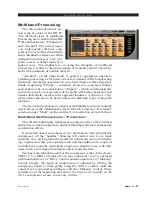
V O R S I S H D P 3 G U I
page 2 – 12
HD P3 / Aug 2006
Signal Path Routing
The various HD P3 modes and features allow for simple or complex
signal paths depending on the state of certain checkboxes in the HD P3
GUI. The following table outlines the various combinations of “switch”
settings and the results that can be seen at the outputs.
NOTES:
1. M/S(i) = M/S switch on Input pane.
2. M/S(o) = M/S switch on Output pane.
3. If both M/S(i) and M/S(o) are ON and the input mode is Stereo,
the M/S function is canceled out.
4. 1 = Analog input channel 1 or Left side of AES input.
5. 2 = Analog input channel 2 or Right side of AES input.
6. L = Left analog or AES Input; R = Right analog or AES input.
Symmetry
Specifically intended for use with voice, for greatest benefit it needs to
occur before any dynamics processing has taken place. By decorrelating
the fundamental and harmonic elements of a voice (far less painful than it
seems) the relatively high asymmetry (“positive” going signal peaks vs.
“negative” going peaks) of some 8 to 10dB of a normal voice can be
substantially reduced, with little audible detriment. This, by in effect
reducing the “peak to average” ratio of the voice signal, can allow a
significant increase in apparent voice loudness in a dynamically controlled
path.
Phase
Phase reversal of the signal path, in case there is an inadvertent reversal
elsewhere in the signal chain of which the HD P3 is a part.
Mode
Stereo
Stereo
Stereo
Stereo
None
AES SPLIT
M/S(i)
M/S(o)
Source
HD P3 ROUTING
Options
Mode
M/S
Input
M/S
Output
L
Analog Out
R
L
R
L
R
L+R
L-R
AES
SPLIT
ON
L
AES Out 1
R
L
AES Out 2
R
Stereo
M/S(i) + SPLIT
ON
ON
ON
L+R
L-R
L+R
L-R
ON
L
R
L
L
L+R
L-R
L+R
L-R
L+R
L+R
L
R
R
R
L+R
L-R
L+R
L-R
L-R
L-R
Mono
None
1
2
1
2
1
2
Mono
AES SPLIT
1
2
ON
1
1
2
2
Mono
M/S(i)
ON
1+2
1-2
1+2
1-2
1+2
1-2
Mono
M/S(o)
1+2
1-2
1+2
1-2
1+2
1-2
Mono
M/S(i) + SPLIT
ON
ON
1+2
1+2
1-2
1-2
1+2
1-2
ON
















































